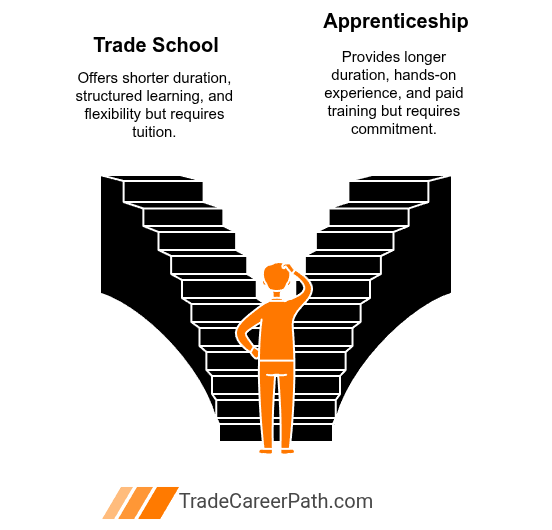Programs Near You
Select a program of interest and we’ll connect you with trade schools that match your goals.
Should You Choose Trade School or Apprenticeship?
If you're serious about joining the skilled trades-whether it's electrical, HVAC, plumbing, or welding-you'll eventually face a big decision:
Should you go to trade school or start an apprenticeship?
Both are proven paths to high-paying, in-demand careers. But the right choice depends on your learning style, budget, timeline, and career goals. This guide breaks down everything you need to know-side-by-side-so you can confidently move forward.
Quick Comparison: Trade School vs. Apprenticeship
| Factor | Trade School | Apprenticeship |
|---|---|---|
| Duration | 6-24 months | 3-5 years (on the job) |
| Cost | $5,000-$30,000+ tuition | Free or paid (earn while you learn) |
| Paid During Training | ❌ No (you pay tuition) | ✅ Yes (hourly wage) |
| Class Format | Structured classroom & lab | Real-world work + supplemental classes |
| Credential Earned | Certificate, diploma, license | Journeyman card, license |
| Best For | Fast learners, schedule flexibility | Hands-on learners, long-term earners |
“Both apprenticeships and technical schools are valuable tools in meeting the country's demand for skilled labor. The best choice depends on the individual.”
- U.S. Department of Labor

Trade School: Fast-Track Your Way Into the Trades
Trade schools (also called vocational or technical colleges) offer formal programs that typically last 6 to 24 months. You'll get structured classroom learning, hands-on lab training, and industry-aligned curriculum focused on job readiness.
✅ Pros
- Faster completion - enter the workforce in 1-2 years
- Predictable schedule - ideal if you're juggling work/family
- Access to instructors and career placement help
❌ Cons
- You pay tuition (often $10,000-$25,000+)
- No income while in school
- Not always enough for licensing-some states still require work hours
“Trade schools are ideal for those who want structured learning and fast entry into the workforce.” - U.S. Department of Education
Apprenticeships: Earn While You Learn
Apprenticeships combine paid, on-the-job training with related classroom instruction-usually through a union, employer, or state-registered program. You'll work under a licensed professional while learning the trade from the ground up.
✅ Pros
- You get paid from day one (starting ~$15-$25/hr)
- Hands-on, real-world experience
- Low or no tuition costs
- Path to journeyman status and long-term career placement
❌ Cons
- Takes 3-5 years to complete
- Schedules can be rigid and physically demanding
- Competitive entry in some regions/trades
“Registered apprenticeships are one of the most reliable pathways to stable, high-wage careers in the trades.” - U.S. DOL Apprenticeship Office
How to Decide: Trade School or Apprenticeship?
Here's how to choose the right path for you:
| Consideration | Trade School | Apprenticeship |
|---|---|---|
| Need to work while training? | ❌ No | ✅ Yes (earn while you train) |
| Want to graduate quickly? | ✅ 6-24 months | ❌ 3-5 years |
| Prefer hands-on over classroom? | ❌ More classroom-based | ✅ 80-90% hands-on |
| Can afford tuition or get aid? | ✅ Eligible for financial aid | ✅ Often free or paid |
| Want direct entry into union? | ❌ May require job hunt | ✅ Often includes union placement |
What Real People Are Saying
“Trade school got me licensed and on the job in 14 months. I'm now an HVAC tech making $65K. Totally worth the tuition.”
- Marcus D., HVAC Technician (Florida)
“I went the apprenticeship route. Started at $18/hour, finished in four years, and now I'm a journeyman earning $82K with full benefits.”
- Natalie P., Electrician (Texas)
Still Not Sure?
You don't have to choose right now-but you do need to get moving. If you're still unsure, consider:
- Reaching out to a union rep or workforce board in your state
- Reading our state-specific guides to understand licensing timelines and costs
Bottom Line
There's no wrong path-only the one that fits your life.
If you're in a hurry, trade school can fast-track your start. If you'd rather earn while you learn, apprenticeship offers long-term stability with real pay from day one.
Both paths can lead to strong, long-term careers with steady demand; outcomes vary by trade and location.